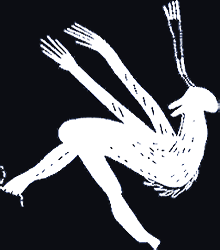 |
 |
The Shamanistic-Visionary Experience
|
Page 3/5 |
When the idea of a religious interpretation of Palaeolithic cave art was first suggested during the second half of the last century it was not well received, to say the least. Today, with the developments in psychology, neurosciences, ethnology, anthropology and archaeology, the shamanistic element in the cave decorations is ever more widely (though not universally) accepted. Approaching these rock paintings from the standpoint of depth psychology, the message is that they are the result of a particularly dynamic arousal of the unconscious due to ritualistic activities that are typically associated with those of shamans, the experts at reaching an ecstatic state of self-abandonment.
Shamanism dates back to the early beginnings of humanity. It originated, it is thought, somewhere in the distant forests of Mongolia from where it spread. By the Palaeolithic period it had become well-established in southern France and northern Spain. Shamans are immensely talented individuals, endowed by nature (enhanced by teaching and practice) with powers of self-control that allow them to fall into a trance at will. In this altered state of consciousness they are thought to hear voices and get information that would otherwise not be accessible to man. Based on research of shamanic rituals of more recent times, we may speculate that the shamanic visionaries of the Palaeolithic period would in a similar fashion to their modern counterparts have induced their trance by enduring intense self-inflicted pain, such as self-mutilation, cold, hunger, and isolation. The Palaeolithic shamanic rites may well have included frenetic, ecstatic dancing to the rhythm of clapping and chanting of mythic words (mantras), that is, all the known elements which eventually bring about an altered state of consciousness.
Rock painting of a dancing transformed shaman
On his return from this blissful though terrible experience, the shaman is able to report on this psychological experience in the symbolic language of the visions. Assuming that the cave paintings were depictions made by shamans following such ecstatic experiences, the cave paintings may be seen to reflect the visionaries' mystical experience. Moreover, since the psychological experience springs from the deep layers of the unconscious concerned not with the personal but with the universal, collective problems of humankind, the paintings are of archetypal nature. The remarkable thing is not that the shamans of the Palaeolithic had the visions they did but that they accepted them as divinely or externally inspired, and that accepting them they translated them into mortal form, the art of their rock paintings. The visions captured in the form of paintings seem to point to a higher, archetypal truth. Rather than giving individual stories, they tell of man's intimate relationship with nature, of his understanding of the coming and going of the seasons and the animal herds, and of man's role as hunter that he has played since time immemorial. Perhaps one of the reasons why the paintings communicate such a sense of wholeness is that they are not man-made but divinely-given masterpieces - man was not their creator; he was the emissary of the creation.
It is more than likely that initially only a few descended into the caves and that selected members of the tribe followed later. Due to their special, magical talents, the shamans would have been singled out as the respected, trusted leaders, as mana personalities who could guide others on their pilgrimage to the world underground. With the shaman in front and the others following, they must have been eager to face unimaginable perils for the purpose of undergoing certain ceremonies which would maybe transform them or heighten their status. As recent research has shown, the caves were visited over millennia when existing paintings were 'edited' and additional ones were made. This could suggest that the original ecstatic experience of the shamans was re-enacted many times over with the same effect of momentarily crossing physical boundaries and seeing both with the bodily eye and the inner, spiritual eye of creation. The animals depicted on the wall are at once related to the real world and to the visionaries' dream world from where they have fleetingly appeared, weightlessly and silently, only to return to the depths of eternity. Perhaps it should no longer surprise us that the animals in the cave paintings are consistently presented without a base-line for support.
Above it was conjectured that for primitive man with his mind still 'in the object' everything in nature had a spirit or a voice. If the Palaeolithic visionary artists did not paint just anywhere but arduously inspected the rock-face for the right place which in its form and contours let them see the finished animal before them, perhaps it was because they were convinced that once found, the right rock would speak to them and tell them what to do. And studying the cave paintings today, we may still have the impression that the very stone itself had been the animal spirit and instructed the artists where to paint and what.
Further Reading:
→
Cave Art: An Intuition of Eternity
→
Dr. Ilse Vickers
→
Bradshaw Foundation Homepage
→
French Cave Paintings & Rock Art Archive


